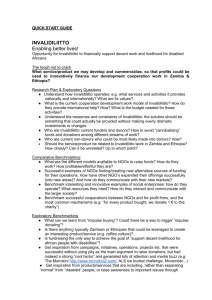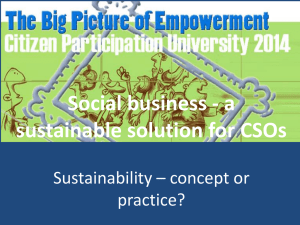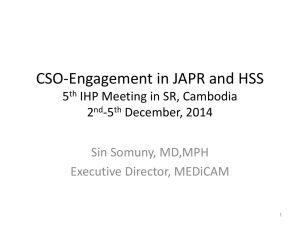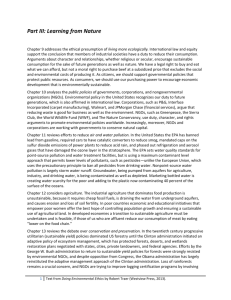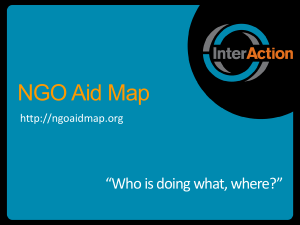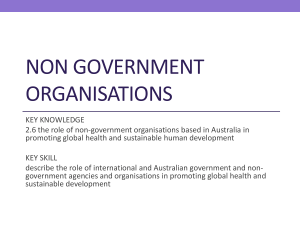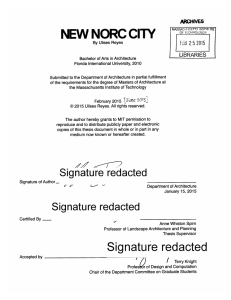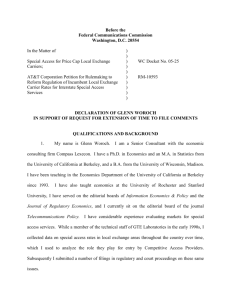Annex 12-2
advertisement
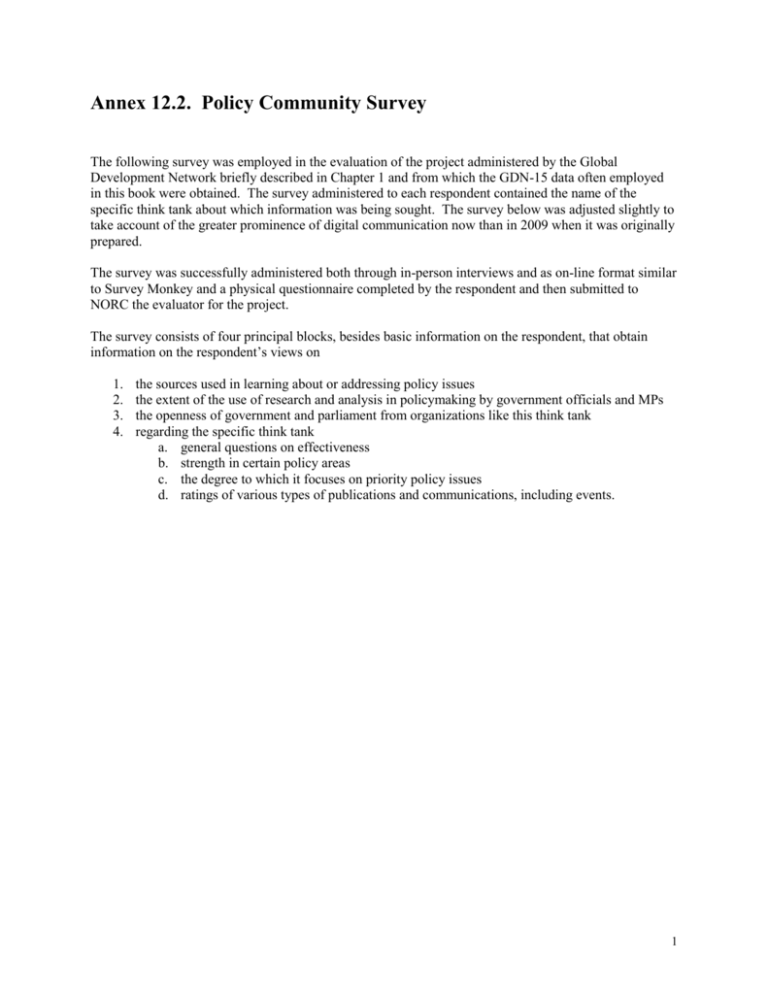
Annex 12.2. Policy Community Survey The following survey was employed in the evaluation of the project administered by the Global Development Network briefly described in Chapter 1 and from which the GDN-15 data often employed in this book were obtained. The survey administered to each respondent contained the name of the specific think tank about which information was being sought. The survey below was adjusted slightly to take account of the greater prominence of digital communication now than in 2009 when it was originally prepared. The survey was successfully administered both through in-person interviews and as on-line format similar to Survey Monkey and a physical questionnaire completed by the respondent and then submitted to NORC the evaluator for the project. The survey consists of four principal blocks, besides basic information on the respondent, that obtain information on the respondent’s views on 1. 2. 3. 4. the sources used in learning about or addressing policy issues the extent of the use of research and analysis in policymaking by government officials and MPs the openness of government and parliament from organizations like this think tank regarding the specific think tank a. general questions on effectiveness b. strength in certain policy areas c. the degree to which it focuses on priority policy issues d. ratings of various types of publications and communications, including events. 1 Survey on Sources of Information for Policy Development and the Performance and Role of the XYZ Institute Introduction The purposes of this survey are to (a) find out where key decision makers, opinion leaders, and stakeholders like yourself get the information you use to inform policy discussions or policy formation, and (b) obtain your views on the performance of [insert organization’s name]. This information is being solicited to provide feedback to the Global Development Network(www.gdnet.org), an international organization that works with policy research organizations, on how successful they have been in improving the quality of these organizations’ analytic work and in improving the communication of their findings to policymakers and concerned citizens. Completion of this survey will typically take 10 to 15 minutes. The identities of all respondents and their individual responses will be kept confidential and only aggregate data (i.e., the combined responses of all or groups of persons who took the survey) will be published. The identities of all respondents and any information from which an identity may be obtained will be removed before disclosing individual responses to GDN. The survey is being conducted by the National Opinion Research Center, part of the University of Chicago (www.norc.org). If you have questions about the survey, please email Mawadda Damon at Damon-Mawadda@norc.org. The completed survey can be returned by any of the following options: Email: Post: To Mawadda Damon at Damon-Mawadda@norc.org Mawadda Damon, NORC, 4350 East West Highway, Bethesda, MD 20814, USA1 We thank you in advance for assisting us with the completion of this survey. Your input is greatly valued and appreciated. Respondent’s name: __________________________ [We ask for your name only so that we can contact you to clarify answers, if necessary. Your name will NOT be entered into the data base with your answers.] In conformation with NORC policy we are disclosing the following information. This study is funded by the UK Department for International Development (DfID). Your participation in this survey is voluntary. You may refuse to participate or may discontinue your participation at any time without penalty. The study will help policy research organizations improve their capabilities and will help the donor community better support such organizations. We may ask your opinions on this subject again in a few years. This survey is being conducted under the direction of Ray Struyk who can be reached at struyk-ray@norc.org. 1 The organization will gather all forms mailed and send them to NORC. They will not open the packages. 2 A. Respondent Type A.1 Which area and position (maximum of two) best characterize your current professional life? Place an “X” in the empty column to indicate applicable areas. Area / position National senior government official (minister, deputy minister, or equivalent in regional or local government) Sub-national senior government official (minister, deputy minister, or equivalent in regional or local government) Advisory to senior official Government official Member of parliament Leader or staff at an advocacy NGO Leader or staff at another type of NGO Leader or staff at a think tank Reporter/editor Other position in the media Academic Other (name) A.2 Have you ever received money for services or provided money to the organization to perform services for you, i.e., through a grant or contract work? ____ yes _____ no B. Sources of Policy Information B.1 When a new policy issue for which you have responsibility or which directly concerns you arises, where do you typically look for information? Rate each source on the following scale: 0= never use 1=go to occasionally 2=use or consult quite often 3=this is one of my primary sources Information Source Relevant government ministry or agency Government research institutes International agencies like the World Bank, UNDP, etc Local think tanks or policy research NGOs Local advocacy NGOs Professors and university institutes Search the internet Other (name) Frequency B.2 How would you rate each of these sources as to the quality of their work and the applicability of the information and analysis to the actual problems in your country? For both parts use a rating scale from 1 to 5 with 5 indicating the highest quality or best applicability and 1 indicating the lowest and least.You also have the option to enter N/A (not applicable) if you do not use this information source. 3 Information Source Relevant government ministry or agency Government research institutes International agencies like the World Bank, UNDP, etc Local think tanks or policy research NGOs Local advocacy NGOs Professors and university institutes Search the internet Other (name) Quality Applicability B.3 In the past year have you consulted with anyone at the types of organizations listed below on a particular policy issue? “Consulted” means you met with them or called them to get information for a general policy discussion or to learn of the results of the organization’s work, etc. The consultation could have been organized by either party. For each type of organization consulted write the number of times you consulted with this type of organization, e.g., if you consulted think tanks 3 times, place a 3 in the response cell next to “Local think tanks or policy research NGOs.” Information Source Relevant government ministry or agency Government research institutes International agencies like the World Bank, UNDP, etc Local think tanks or policy research NGOs Local advocacy NGOs Professors and university institutes Search the internet Other (name) C. No. of times Use of research and analysis in policymaking C.1 How would you rate the frequency with which well-organized data, research and analysis are used in policymaking in this country, by government ministries? Mark the answer that best describes the situation for each. Frequency This is standard procedure now This happens sometimes but is rather exceptional This practice is still quite rare with us Essentially never Don’t know Government C.2 How would you rate the frequency with which such research and analysis are used in the following specific policy areas, by government ministries? Place an “X” in the one box that best applies for each column. 4 Frequency Accountability Issuesa Area 2 Area 3 This is standard procedure now This happens sometimes but is rather exceptional This practice is still quite rare with us Essentially never Don’t know a. Issues having to do with the proper application of government funds (corruption) and the efficiency of government spending. [Other areas for each organization will be filled after the areas are identified.] C.3 How would you rate the frequency with which well-organized data, research and analysis are used in policymaking in this country, by the parliament? Mark the answer that best describes the situation for each. Frequency This is standard procedure now This happens sometimes but is rather exceptional This practice is still quite rare with us Essentially never Don’t know Parliament C.4 How would you rate the frequency with which such research and analysis are used in the following specific policy areas, by the parliament? Place an “X” in the one box that best applies for each column. Frequency Accountability Issuesa Area 2 Area 3 This is standard procedure now This happens sometimes but is rather exceptional This practice is still quite rare with us Essentially never Don’t know a. Issues having to do with the proper application of government funds (corruption) and the efficiency of government spending. [Other areas for each organization will be filled after the areas are identified.] C.5 Do you think that senior Government officials are really willing to accept input or use reports from think tanks and research-advocacy NGOs when they are making policy? Answer on a scale from 1 – 4 (4=very willing). Rating: _____________ C.6 Do you think that a significant share of members of parliament are really willing to accept input or use reports from think tanks and research-advocacy NGOs when they are making policy? Answer on a scale from 1 – 4 (4=very willing). Rating: _____________ 5 C.7 How would you rate government funding for policy analysis by private organizations such as think tanks, now and compared with two years ago? Place an “x” in the box next to the answer in each column that best fits your view. Rating of Current Situation Situation Funding is quite generous Some funding is available but it fairly limited Only quite modest funding Almost none or none is available Don’t know Current Situation Compared to Two Years Ago Situation Compared A major increase over the period Modest increase over the period About the same Some reduction over the period Don’t know C.8 Please rate the change in policies in the past year or two in the following areas. Place an “X” in the box for the answer that best applies. Area Visible improvement Some but not much improvement No change Don’t know Budget policies or expenditures management improvements Increased transparency and accountability in budget policy and public expenditures management D. Questions about [name organization] D.1 How familiar are you with the organization’s work? Place an “x” next to the most accurate response. Degree of familiarity 1. very familiar 2. somewhat 3. not much 4. heard of the name only 5. not at all If you answered, “not at all,” stop here and submit the form. Many thanks for your help! D.2 How may years have you been familiar with their work? Place an “x” next to the most accurate response. Degree of familiarity 1. 5 years or more 2. 3-5 years 3. 1-2 years 4. just recently learned about them 6 D.3 General views. Question Very much Somewhat Not much Not at all Don’t know 1.Are the organization’s policy recommendations helpful? 2.Is the organization a valuable source of research, including data and statistics? 3.Does the organization’s work positively impact public policy or administration? 4.Does the organization have an impact in holding the government accountable for public expenditure quality, i.e., efficient and honest use of public resources? 5.Does the organization have an influence on the budget making process in terms of openness, quality or equity of budget choices? 6.Does the organization effectively partner with other domestic civil society organizations or NGOs in developing analysis or working for change? 7.Does the organization effectively partner with international civil society organizations or private sector entities? 8.Does the organization operate transparently and openly? D.4 How would you rate the value to you of each of the following aspects of the organization’s work? Use a rating scale from 1 to 4, with 4 indicating the highest value to you and 1 the least. If you have no opinion for a category, leave the answer blank. Type of activity Financial analysis skills Regional or local knowledge Sector expertise Policy knowledge Communications and outreach skills Networking activities Role as government monitor or critic Source of diverse and neutral opinions on analyses produced by others D.5 Rating Agenda. For the following question, please mark the answer that best describes your opinion. Question Very much Somewhat Not much Not at all Don’t know Does the organization focus on issues that are of high priority? 7 D.6 Over the past three years have you personally used any of the organization’s publications? _____ yes – continue to the next question _____ no – go to question D.8 D.7 Views on publications. Check the answer box that most closely corresponds to your view. Question Very much Somewhat Not much Not at all Varies too much to responda Don’t know 1.Are the organization’s publications easy to understand? 2. Are they readily available and easy to get? 3.Are they interesting and informative to read? 4. Is the information contained in them reliable? 5. Are they timely? 6. Have they changed the way you think about certain economic, policy or social issues? a. The publications differ in their quality, etc. a great deal so that one cannot give a single response. D.8 Communications Check the answer box that most closely corresponds to your view. Question Very well Somewhat well Not very well Not well at all Don’t know Once a month or more often Every couple of months 1-2 times a year Never Don’t know 1. How well does the organization communicate its mission, program, and activities, directly or indirectly? 2. How well does the organization do in consulting with members of the public and civil society organizations to obtain input or obtain information? 3.In general, how often do you see the organization or its work mentioned in newspapers or magazines? 4.How often do you see or hear the organization or its work mentioned on television or radio? 5.How often do you have face-toface meetings with staff from the organization? 6.How often do you receive letters, memos, reports or publications or correspondence from the organization? 7.How often do you use the organization’s web site? 8 8.How often do you read blogs posted by this organization? 9.How often do you read their Facebook and Twitter postings? Very much Somewhat Not much Not at all Don’t know Once a month or more often Every couple of months 1-2 times a year Never Don’t know Very well done Above the usual level Typical Below the average Don’t know 10.Does its web site provide the information you need? 11.Is the web site easy to use? 12.In the past year how often have you participated in events that the organization arranged? 13.How do you rate the content of these events? 14.Were the events well organized in terms of logistics? 15.Did the events include the right people, i.e., those most concerned and knowledgeable on the issue? 9


